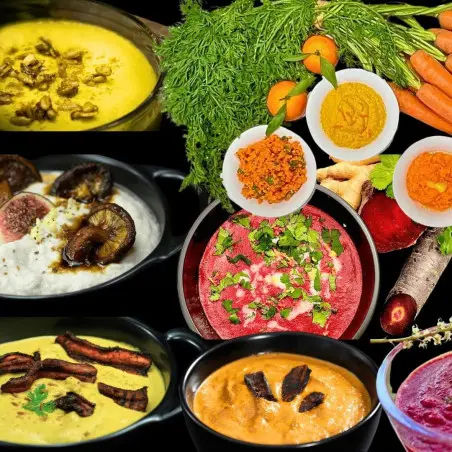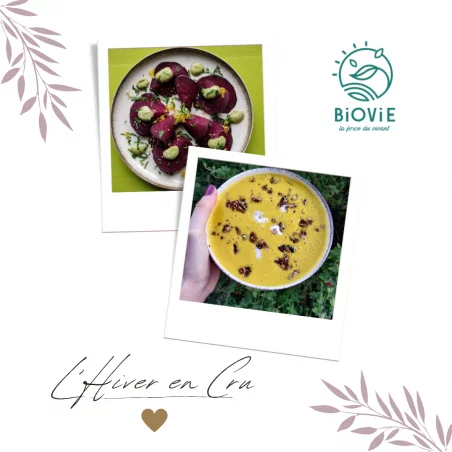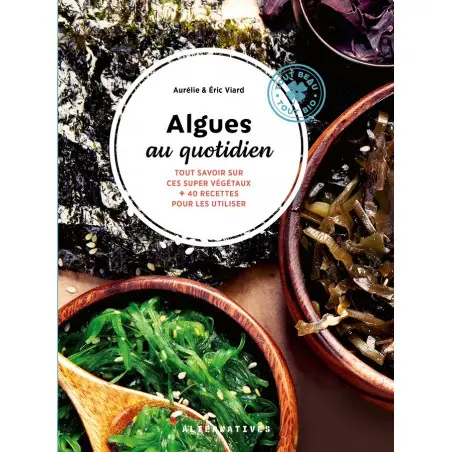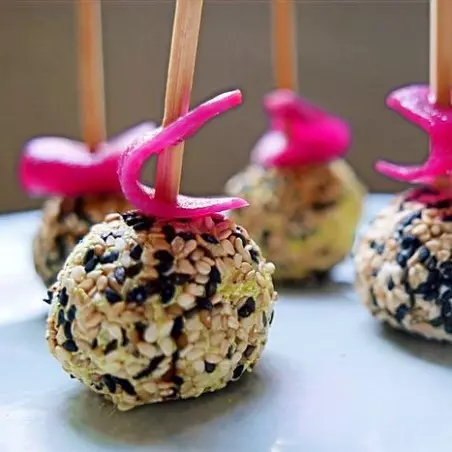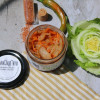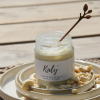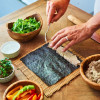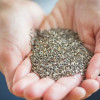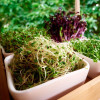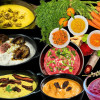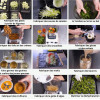Living Food often raises many questions and preconceived notions. In this article, we will explore and demystify five common misconceptions about this nutritional approach. You will discover why living food is much more diverse, tasty, and accessible than you might think, especially compared to modern diets, which often focus on processed products.
After reading this, you will have:
- A better understanding of what living food really is,
- Arguments to counter the most common misconceptions,
- Practical ideas to integrate living food into your daily life,
- A clearer vision of the benefits of this dietary approach.
1. "Eating raw means eating cold"
The idea that eating raw equates to consuming only cold foods is a common but misleading misconception. In reality, "raw" does not necessarily mean "cold". The distinction is important: a raw food is simply uncooked, but that doesn't prevent it from being warmed to a pleasant temperature, as long as it doesn't exceed 42 degrees Celsius to preserve its nutrients and enzymes.
There are several techniques to enjoy raw foods while benefiting from warmth:
The dehydrator: a valuable ally
The dehydrator is an essential tool for those who wish to explore the delights of living food while enjoying warm and comforting dishes. This ingenious device works by removing moisture from foods at low temperatures, usually around 42 degrees Celsius, thus preserving their digestive enzymes and essential nutrients. Unlike traditional cooking, dehydration allows for the preservation of the vitality of foods while offering a unique texture and flavor.
Using a dehydrator is relatively simple and offers a multitude of culinary possibilities. Whether it's for making crunchy crackers, dried fruits, or even raw pizzas, this appliance allows you to experiment with innovative recipes. For example, you can make crispy kale chips or homemade fruit rolls, perfect for healthy and tasty snacks. The dehydrator also allows you to create dishes that mimic the warmth and comfort of cooked meals while staying true to the principles of raw food.
By incorporating the dehydrator into your kitchen, you open the door to a diet rich in flavors and nutrients while exploring creative and varied cuisine. You will prove that eating raw and organic does not mean giving up the warmth or texture so appreciated in traditional dishes. Explore the countless possible recipes and rediscover the pleasure of cooking in a way that is respectful to your body and the planet.
Warm Dishes and Raw Soups
When talking about raw food, it's easy to think it is limited to cold dishes. However, there are a multitude of raw recipes that can be consumed warm, providing comfort and satisfaction while respecting the principles of rawness.
Raw Soup: A Comforting Warmth
Take the example of raw soups. With a powerful blender, it is possible to blend your favorite vegetables into a creamy soup, allowing the mixture to slightly heat through friction. This method ensures that temperatures remain low enough to preserve the nutritional benefits of the foods while offering a pleasantly warm soup. You can enrich your soup with spices and fresh herbs for a burst of flavors.
Vegetable Wraps: A Diversity of Tastes and Textures
Warm dish recipes are not limited to soups. Think of vegetable wraps, where cabbage or lettuce leaves serve as a base for a delicious mix of crunchy vegetables and raw dips, made from natural products. These meals provide a variety of textures and tastes while being easy to prepare, even for beginners.
In conclusion, eating raw does not mean giving up warm and comforting dishes. With a bit of creativity and the right tools, you can easily incorporate warm dishes into your raw food diet, transforming each meal into a pleasant and nutritious culinary experience.

2. "Eating raw is bland"
Contrary to the common belief that raw food lacks flavor, it actually offers an explosion of natural tastes. Raw foods retain their own essence, allowing you to savor authentic and intense flavors that are often diminished by cooking. A good alternative to traditional dishes, this cuisine allows you to explore an infinite variety of textures and aromas. The judicious use of spices and fresh herbs adds an extra dimension, transforming even the simplest recipes into true culinary delights. Herbs like basil, cilantro, and mint, or spices such as turmeric and cumin, not only enhance dishes but also add undeniable nutritional benefits.
Fermentation: a flavor boost
Fermentation is an ancient process that brings a unique taste dimension to raw foods. Through this process, microorganisms like bacteria and yeasts transform the natural sugars in foods into lactic acid, alcohol, or other compounds, thus enriching their flavors. Fermented foods, such as kimchi, sauerkraut, or kombucha, are prized for their tangy taste and complex aromatic profile.
Benefits of Fermentation
- Improved digestibility: Fermentation improves the digestibility of foods.
- Probiotic boost: It increases the probiotic content, essential for gut health.
- Immune system strengthening: Good bacteria strengthen the immune system and aid digestion.
To incorporate fermentation into your raw food diet, try making fermented cabbage or homemade pickles. These preparations are simple to make and bring an explosion of flavors to your raw meals, proving that eating raw can be a rich and flavorful culinary adventure.
Marinades, chutneys, and raw sauces
Marinades, chutneys, and raw sauces are essential for those who wish to enhance the flavors of their dishes. By combining ingredients such as lemon juice, olive oil, tamari, and a variety of herbs and spices, you can create marinades that infuse raw vegetables, fruits, and nuts with varied and delicious flavors.
Examples of marinades
- Asian marinade: Ginger, garlic, and sesame oil for an Asian taste experience.
- Mediterranean marinade: Lemon juice, olive oil, and herbes de Provence.
Examples of raw sauces
- Mexican sauce: Avocado and cilantro for a Mexican touch.
- Raw pesto: Cashew nuts and basil for a creamy sauce.
These preparations are not only easy to concoct, but they also allow for great culinary creativity, proving once again that raw food is anything but bland. By experimenting with marinades and sauces, you will discover a multitude of flavors and textures that will enrich your daily plant-based and raw diet.

3. "Eating raw is monotonous"
Raw food is not synonymous with monotony. In reality, it offers an incredible diversity of ingredients and preparations that allow for the creation of varied and inspiring dishes. Contrary to popular belief, eating raw is not limited to a simple salad of raw vegetables. One of the main advantages of this approach is the ability to play with colors, textures, and flavors, making each meal unique and exciting.
The diversity of ingredients in raw food is astounding. From crunchy vegetables to juicy fruits, including nuts, seeds, seaweeds, and superfoods, the possibilities are endless. These ingredients can be prepared in multiple ways, whether in the form of smoothies, wraps, raw sushi, or even gourmet desserts made from nuts and dried fruits. Each dish can offer a different culinary experience, thus proving that raw food is far from boring.
Experimenting with different textures and preparations is another way to push back monotony. By combining spiralized vegetables, creamy nut purees, juicy raw fruits or sprouted seeds, you can vary the pleasures and discover new taste sensations. This culinary approach not only encourages creativity but also a continuous exploration of new combinations and flavors, demonstrating that raw food is both diverse and exciting.
Beyond Salads: Elaborate Dishes
The perception that raw food is limited to bland salads is a misconception far from reality. In fact, raw cuisine can prove to be a rich and inventive culinary playground, allowing for the creation of dishes as complex as they are surprising. Imagine raw sushi, where nori sheets wrap a colorful mix of crunchy vegetables, exotic fruits, and creamy nut-based purees. These creations not only satisfy the palate but also amaze with their visual aesthetics.
Next, explore the world of raw tarts: a subtly sweet crust made from dates and nuts, topped with a creamy cashew nut filling and garnished with fresh fruits or colorful coulis. The absence of cooking preserves the freshness and intense flavors of the ingredients, offering a unique taste experience.
Raw spring rolls are another excellent illustration of the diversity and sophistication possible with raw foods. Wrapped in soaked rice papers, vegetables, fresh herbs, and sprouts combine to create a perfect balance between crunchy textures and aromatic flavors. Adding a sauce made from nuts or seeds brings an additional dimension of taste.
These examples demonstrate that raw food, in addition to promoting a balanced diet, is far from monotonous and lends itself to endless creativity. By stepping off the beaten path, you will discover a culinary world where sophisticated and flavorful dishes are within reach of anyone who wishes to experiment and fully savor each meal.
Superfoods: A Palette of Flavors
Superfoods play a crucial role in enriching living foods, offering a multitude of flavors and nutritional benefits. These foods, often rich in essential nutrients, are an excellent way to add variety and originality to your raw meals. From seaweeds to chia seeds and spirulina, each superfood brings its own signature taste and texture, making living foods both diverse and nutritious.
Organic seaweeds, for example, are not only a fantastic source of minerals and vitamins, but they also offer a unique umami flavor that can energize your dishes. They can be incorporated into salads, soups, or even smoothies for optimal nutritional intake. Also discover our two recipe books specially dedicated to seaweeds to explore the benefits of these marine treasures in your daily diet:
> Cooking with Seaweeds, by Marie Claire Editions
> Seaweeds Daily, by Gallimard Editions
Incorporating superfoods into your dietary routine is a simple way to introduce new colors and flavors into your meals. These versatile ingredients can be sprinkled on salads, blended into smoothies, or used to enrich raw sauces. Chia seeds, for example, can create a simple yet delicious pudding, while raw cacao can transform a raw dessert into a gourmet experience.
In summary, superfoods are an invitation to culinary experimentation. They encourage you to step off the beaten path and rethink what it means to eat raw, proving that living foods are anything but monotonous. By integrating these superfoods, you contribute to a varied diet, rich in flavors and essential nutrients. Explore the richness of these ingredients and let your creativity run free to savor every bite in all its diversity.

4. "Eating raw means only eating raw vegetables"
The misconception that adopting a raw diet means limiting oneself to raw vegetables is far from reality. In fact, living food offers an astonishing culinary richness that goes well beyond simple salads. This dietary approach encompasses a variety of ingredients and preparations that allow you to enjoy innovative and delicious dishes, while benefiting from the advantages of a raw diet. It is entirely possible to enjoy a diverse and gourmet cuisine without getting bored.
Sprouted seeds: a world to discover
Sprouted seeds are a true revelation for those venturing into living food. They are not only easy to grow at home, but they are also packed with essential nutrients, making your raw diet not only more nutritious but also more diverse. As foods rich in enzymes, vitamins, minerals, and antioxidants, they offer a burst of health benefits.
Using sprouted seeds
Sprouted seeds can be incorporated into a multitude of dishes:
- Salads: Add crunch and freshness.
- Sandwiches and wraps: For a unique texture.
- Smoothies and soups: Enrich your drinks and liquid dishes.
Among the most popular seeds to sprout are fenugreek, alfalfa, clover, and radish, each offering its own flavors and benefits.
Growing your own sprouted seeds
Growing your sprouted seeds is a simple and rewarding process that can easily be integrated into your daily routine. Here's how to start:
- Necessary equipment: A glass jar and a sprouting lid.
- Growing time: Just a few days to harvest your sprouts.
This activity requires neither space nor specific equipment, and it allows you to consume fresh and living foods all year round. For an even easier and automated process, the Easygreen Sol sprouter offers a practical solution for growing your seeds effortlessly.
Benefits of Sprouted Seeds
By adding sprouted seeds to your meals, you not only enrich your diet in terms of nutrition, but you also diversify your dishes in a natural and accessible way. As living foods, they clearly demonstrate that eating raw can be anything but monotonous, inviting you to explore a vibrant and lively culinary world.
Dried Fruits and Nuts
Within the framework of living food, dried fruits and nuts hold a special place due to their nutritional richness and great versatility. These foods, often considered superfoods, are excellent sources of proteins, healthy fats, fiber, and many essential micronutrients. They play a crucial role not only in energy supply but also in diversifying the textures and flavors of your raw dishes.
Dried Fruits: A Concentrated Source of Nutrients
Dried fruits, such as figs, apricots, or raisins, are nutrient concentrates that can significantly enrich your raw meals. Their high fiber content makes them excellent allies for digestion, helping to prevent digestive disorders, while their natural sweetness can replace refined sugars in desserts and snacks. For example, Medjool dates are often used as a natural sweetener in raw pastries, providing a unique caramelized flavor and a soft texture.
Nuts: Diversity and Benefits
Nuts, like almonds, cashews, or hazelnuts, are essential ingredients in living food. Rich in essential fatty acids, proteins, and minerals such as magnesium and zinc, they help maintain good cardiovascular health and strengthen the immune system. Transformed into butters or creams, they bring a luxurious creaminess to your raw dishes. For example, a cashew-based sauce can serve as a base for dishes like vegetable pâtés or raw cheeses.
Creative Uses
Dried fruits and nuts are crucial ingredients for creating a multitude of creative recipes in living food. Here are some ideas to incorporate them into your meals:
- Raw Energy Bars: mix dates, nuts, and seeds to create perfect energy snacks for an on-the-go treat.
- Homemade Plant-Based Milks: prepare almond or hazelnut milks for a nutritious and tasty alternative to dairy products.
- Raw Desserts: make raw tarts or cheesecakes using a base of nuts and dried fruits for a naturally sweet flavor.
By incorporating dried fruits and nuts into your raw diet, you will not only benefit from their nutritional properties, but you will also discover an infinite palette of varied and delicious flavors. These ingredients offer culinary flexibility that proves that a raw food diet can be both simple and extraordinarily satisfying.

5. "Eating raw is complicated"
The perception that a raw food diet is synonymous with complexity is a misconception that it's time to dispel. In reality, adopting a simple and organized approach can transform this practice into an easy and satisfying lifestyle. It is primarily about demystifying the preparation of raw foods and equipping yourself with the right tools to get started. Contrary to what one might think, it is not necessary to be a star chef to create delicious and nutritious raw dishes. With a few basic techniques, you can easily integrate raw food into your daily life.
To start, it is important to familiarize yourself with simple recipes that require neither cooking nor sophisticated equipment. For example, composed salads enriched with sprouted seeds, green smoothies, or bowls of dried fruits and nuts can make excellent raw meals, quick and easy to prepare. These dishes require only a few minutes of preparation and are perfect for a raw food diet accessible to everyone.
Organization also plays a crucial role in the success of your transition to a raw food diet. Taking the time to plan your meals in advance and prepare your ingredients ahead of time can make all the difference. For example, pre-cutting your vegetables, soaking your nuts, or sprouting your seeds are simple actions that greatly facilitate daily life. By optimizing your organization, you ensure that eating raw remains an enjoyable and enriching experience, proving that this dietary approach, far from being complicated, is within reach of anyone wishing to improve their well-being.
Easy Recipes for Beginners
Entering the world of raw food may seem intimidating, but with a few simple recipes, you'll quickly discover that eating raw is both doable and delicious. Here are some quick and accessible dish ideas that require neither cooking nor specialized equipment, perfect for beginners.
Crunchy Vegetable and Sprouted Seed Salad
Start with a simple yet nutritious salad. Use a base of lettuce or spinach, add colorful vegetables like grated carrots, diced cucumbers, and sliced peppers. Sprinkle with sprouted seeds of your choice, such as alfalfa or radish, for a nutritional boost. Season with a raw dressing made from lemon juice, olive oil, and fresh herbs. This salad is not only quick to prepare but also rich in flavors and textures.
Revitalizing Green Smoothie
A green smoothie is an excellent way to start the day. Blend a handful of kale or spinach leaves with a banana, half an avocado, and a cup of coconut water. Add a teaspoon of spirulina for an extra boost of nutrients and to maximize nutritional intake. Blend everything until smooth. This smoothie is not only hydrating and nourishing but also incredibly easy to make, providing lasting energy for the day.
Red Berry and Cashew Cream
For a quick raw dessert, try a red berry and cashew cream. Soak half a cup of cashews for a few hours. Drain and blend with a cup of fresh or frozen red berries, a date for slight sweetness, and a pinch of vanilla. Serve immediately to enjoy a creamy and fruity treat, perfect for satisfying a sweet craving while staying healthy.
Organization: Key to Successful Raw Food Eating
The key to integrating raw food into your daily life lies in good organization. A bit of preparation and planning can make this transition smoother.
Practical Tip: Meal Planning
Start by planning your meals for the week. List the necessary ingredients and ensure they are easily accessible. Prepare your vegetables in advance: wash, peel, and chop them to save time when preparing meals. You can also soak your nuts and seeds at the beginning of the week, then store them in the refrigerator for quick use.
Smart Storage
Invest in good quality airtight containers to store your prepared foods. This will help extend their freshness and simplify the organization of your kitchen space. In addition to essential kitchen utensils for preparation, glass jars are ideal for storing sprouted seeds, while reusable silicone bags can keep your fruits and vegetables ready to use.
By incorporating these simple practices into your routine, you'll find that raw food eating can be not only easy but also a daily joy. You will discover a healthier, more energizing lifestyle, and more environmentally friendly, proving that eating raw is much more accessible than it seems.
> In our store, in our Learn section, you will find a multitude of resources with recipes, advice and tips, in the form of books, webinars, or courses. Feel free to make your choice from this wide range of programs and educational content, adapted to all levels, from the simple novice to the great gastronomic chef.

Conclusion
Living food, often surrounded by misconceptions, turns out to be a rich and varied culinary approach once these myths are deconstructed. We have explored how it is possible to eat raw without being restricted to cold or bland foods, and how this diet can be anything but monotonous thanks to an impressive diversity of ingredients and preparations. Beyond simple raw vegetables, this approach allows for experimenting with warm and comforting dishes, while remaining simple to prepare.
By demystifying these preconceived ideas, we hope to inspire you to incorporate more raw foods into your daily life. Living food is not just about health, but also a way to reconnect with authentic flavors and develop a rewarding and sustainable lifestyle. We invite you to continue this culinary exploration and to subscribe to our newsletter to regularly receive practical tips, innovative recipes, and inspiring information on well-being and sustainability.
Your Questions and Our Answers (FAQ)
Does eating raw always mean eating cold?
No, eating raw does not necessarily mean eating cold. Raw foods can be heated up to 42 degrees Celsius without losing their essential nutrients. Devices like a dehydrator or a powerful blender can help you enjoy warm raw dishes, such as soups or slightly warmed vegetables.
Is living food bland?
Far from it! Eating raw allows you to discover intense and authentic flavors. Raw foods retain their natural tastes that cooking often diminishes. Spices, fresh herbs, and techniques like fermentation enrich dishes with complex and savory flavors.
Is eating raw monotonous?
Absolutely not. Living food offers incredible diversity. You can make raw sushi, zucchini lasagna, or tarts made from dried fruits. Experimenting with varied textures and superfoods makes each meal unique and exciting.
Does eating raw mean only eating raw vegetables?
No, living food is not limited to raw vegetables. It includes a variety of ingredients like sprouted seeds, dried fruits, and nuts. You can prepare sophisticated dishes like dehydrated crackers or gourmet raw desserts.
Is a raw food diet complicated to follow?
A raw food diet can be simple and accessible with a bit of organization. Plan your meals, prepare your ingredients in advance, and use tools like a good blender to make preparation easier. With a few basic recipes, you can easily incorporate this lifestyle into your daily routine.
What are the benefits of superfoods in a raw food diet?
Superfoods enhance a raw food diet by providing a range of flavors and nutrients. Ingredients such as seaweed, goji berries, and spirulina add exotic notes and increase the nutritional value of your dishes.
How to start simply with a raw food diet?
Start with simple recipes like crunchy vegetable salads, green smoothies, or nut creams. Prepare your ingredients in advance and use suitable tools to make preparation easier. Organization is key to a successful raw food diet.




